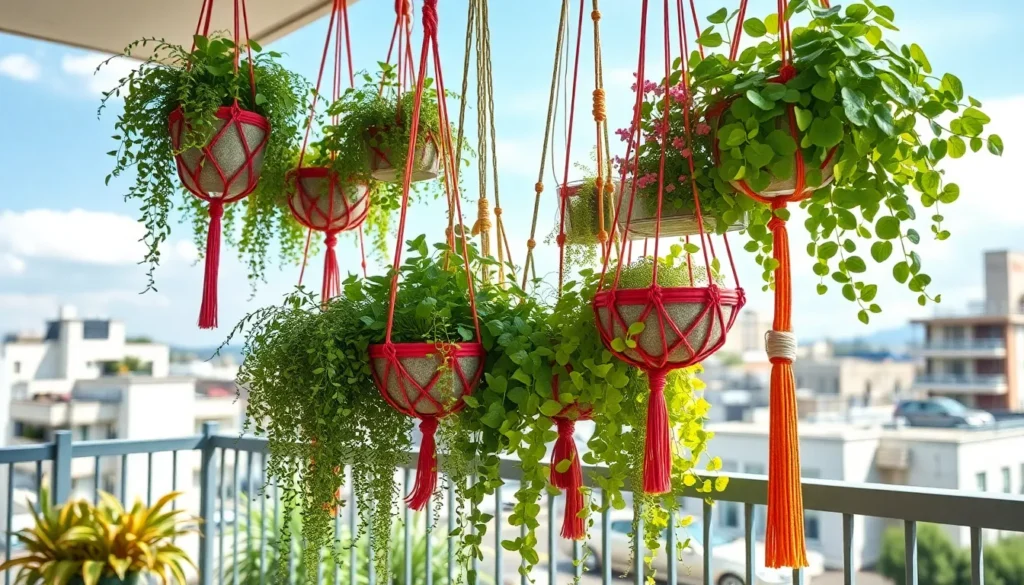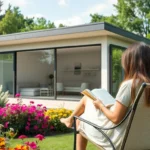We’ve all dreamed of having a lush garden but felt limited by space constraints or poor soil conditions. That’s where hanging gardens come to the rescue – they’re the perfect solution for transforming any area into a verdant oasis, whether you’re working with a tiny balcony or a spacious backyard.
Hanging gardens aren’t just space-savers; they’re conversation starters that add vertical interest and natural beauty to your living space. From cascading herbs that’ll elevate your cooking to stunning flowering displays that create living art, these elevated gardens offer endless possibilities for creative expression.
We’ll explore innovative hanging garden ideas that work for every skill level and budget. Whether you’re a seasoned gardener looking to maximize your growing space or a beginner eager to start your first green project, these vertical answers will help you create the garden you’ve always wanted – without requiring a single square foot of ground space.
Vertical Wall Hanging Gardens for Small Spaces
Vertical walls transform cramped spaces into flourishing green sanctuaries. We’ll explore three innovative approaches that maximize growing potential while minimizing floor space requirements.
Living Wall Planters and Pocket Systems
Living wall planters create stunning vertical displays using fabric pockets or modular containers. These systems work exceptionally well for herbs, succulents, and small flowering plants like petunias or impatiens.
Felt pocket planters attach directly to walls and hold multiple plants in individual compartments. We recommend choosing systems with at least 6-8 pockets for visual impact. Popular brands like Florafelt and Woolly Pocket offer durable options that last 3-5 years.
Stackable planter boxes provide another excellent solution for apartment dwellers. Tower Garden and GreenStalk systems allow vertical stacking up to 6 feet high. Each tier holds 4-6 plants, giving you growing space for 20-30 plants in just 2 square feet of floor area.
Irrigation considerations become crucial with living walls. Drip irrigation systems or self-watering planters prevent water damage to interior walls. We suggest installing a catch tray at the bottom to collect excess moisture.
DIY Pallet Garden Installations
Pallet gardens offer budget-friendly vertical growing answers using reclaimed wooden shipping pallets. Heat-treated pallets marked with “HT” stamps provide the safest option for food plants.
Preparation steps involve sanding rough edges and adding industry fabric backing. We staple the fabric securely to create planting pockets between slats. This process typically takes 2-3 hours for one standard pallet.
Plant selection works best with shallow-rooted varieties. Lettuce, spinach, strawberries, and herbs thrive in pallet gardens. Each pallet accommodates 8-12 plants depending on their mature size.
Mounting methods require sturdy wall anchors rated for 50-75 pounds when fully planted and watered. We recommend using heavy-duty wall brackets spaced 16 inches apart to distribute weight evenly across wall studs.
Maintenance tasks include weekly watering and monthly fertilizing. Pallet gardens dry out faster than ground plantings, so daily moisture checks prevent plant stress during hot weather.
Modular Panel Growing Systems
Modular panels provide professional-grade vertical gardening with expandable configurations. These systems feature interlocking components that adapt to various wall sizes and shapes.
Hydroponic integration works seamlessly with panel systems like Tower Farms or Bright Agrotech installations. Nutrient answers circulate through channels, delivering precise feeding to each plant location.
Plant capacity varies by panel size, with standard 4×4 foot panels supporting 16-25 plants. We can combine multiple panels to create walls spanning 8-12 feet for dramatic visual impact.
Installation requirements include electrical connections for pump systems and adequate drainage planning. Professional installation typically costs $15-25 per square foot, while DIY kits range from $8-12 per square foot.
Crop rotation becomes simple with removable growing cups. We can harvest mature lettuce from top rows while seedlings establish in lower positions, maintaining continuous production cycles.
Indoor Hanging Garden Ideas for Year-Round Growing
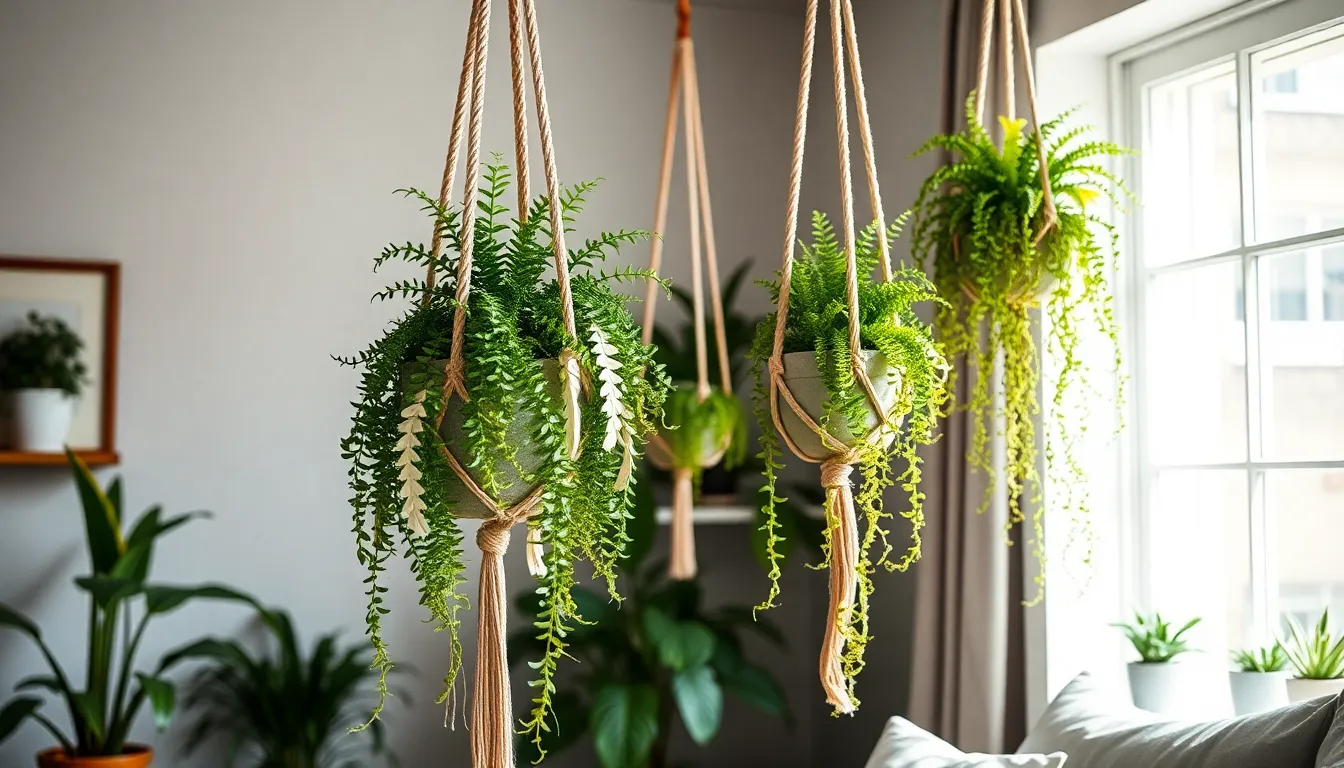
Creating indoor hanging gardens opens up exciting possibilities for year round plant cultivation, especially when outdoor conditions become challenging. We’ll explore three versatile approaches that transform any interior space into a thriving garden sanctuary.
Macrame Plant Hangers and Suspended Pots
Macrame hangers offer one of the most stylish ways to display suspended plants while adding bohemian charm to your living space. We recommend using these decorative holders for plants like ferns, ivy, and air plants that naturally cascade or spread in attractive patterns. These customizable hangers adapt to various room styles and ceiling heights, making them perfect for apartments or homes with limited floor space.
Creating your own macrame hangers allows for personalization in both size and design complexity. Plants such as pothos, spider plants, and trailing succulents thrive in these suspended environments while creating stunning visual displays. The natural fiber construction complements most interior design schemes while providing sturdy support for medium weight planters.
Ceiling-Mounted Garden Rails
Installing ceiling mounted garden rails maximizes your vertical growing space by creating organized rows of hanging planters throughout any room. We find this system particularly effective for plants requiring minimal maintenance, including succulents and cacti that prefer consistent conditions without frequent watering. The rail system distributes weight evenly across ceiling joists while allowing easy access for plant care.
Multiple planters or baskets can hang from a single rail installation, creating impressive garden walls without occupying valuable floor area. This setup works exceptionally well in kitchens for herb gardens or in living areas for decorative plant collections. Rails can extend across entire walls or focus on exact zones depending on your space requirements and design preferences.
Window Hanging Garden Displays
Window spaces provide ideal locations for hanging planters that take advantage of natural light sources throughout the day. We attach hanging containers directly to window frames, creating perfect growing conditions for herbs and small leafy greens that benefit from consistent sunlight exposure. This positioning eliminates the need for additional grow lights while keeping plants easily accessible for harvesting.
Small vegetables like cherry tomatoes, lettuce, and microgreens flourish in window hanging displays when positioned to receive adequate daily sunlight. The proximity to natural light sources promotes healthy growth while reducing energy costs associated with artificial lighting systems. Window gardens also create beautiful living curtains that provide privacy while maintaining garden productivity year round.
Outdoor Patio and Balcony Hanging Gardens
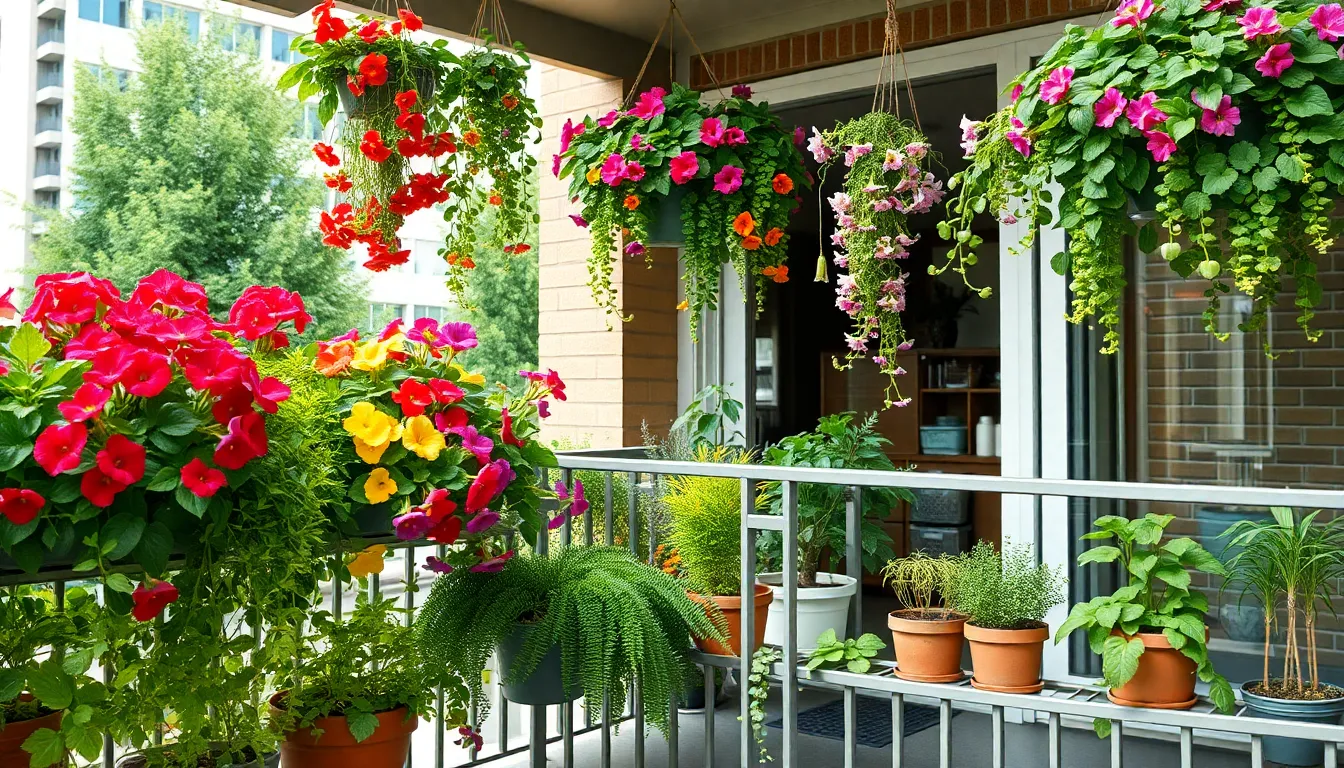
Outdoor spaces present unique opportunities for expanding our growing area beyond interior walls. These elevated garden designs transform patios and balconies into productive green sanctuaries that maximize every available inch.
Weather-Resistant Hanging Planters
UV-stabilized plastics offer exceptional durability against sun damage while maintaining their structural integrity throughout multiple seasons. Powder-coated metals resist rust and corrosion, making them ideal for areas exposed to rain and humidity. Treated woods provide natural aesthetics while withstanding outdoor elements when properly maintained with seasonal care.
Self-watering features reduce our maintenance responsibilities by delivering consistent moisture to plants without daily intervention. These systems include built-in reservoirs that release water gradually, preventing both overwatering and drought stress. Proper drainage holes prevent water accumulation that could damage both plants and mounting structures during heavy rainfall.
Secure mounting becomes critical when wind conditions intensify, requiring heavy-duty brackets and weather-resistant hardware. We recommend checking mounting points quarterly to ensure continued stability as planters expand with growth.
Pergola and Arbor Garden Installations
Climbing plants such as roses, wisteria, and ivy transform pergola structures into living canopies that provide natural shade and visual appeal. These installations support vertical growth along trellises and cross beams, creating multi-level garden displays. Additional hanging baskets enhance plant variety by introducing species that cascade downward from elevated positions.
Structural support requirements vary based on plant weight and growth patterns, with mature climbing vines requiring reinforced mounting points. We position containers strategically to balance weight distribution across pergola beams. Cross beam installations allow for both decorative flowering plants and edible climbing varieties like grape vines or pole beans.
Natural shade creation occurs as plants mature, reducing temperature fluctuations beneath the structure while protecting other plants from intense sunlight. This microclimate effect extends growing seasons for heat-sensitive varieties positioned below the canopy.
Railing-Mounted Garden Systems
Bracket attachments secure directly to railing posts without requiring floor space, making them perfect for narrow balconies and compact decks. These systems accommodate pots, troughs, and modular planters while maintaining safe clearances for foot traffic. Pouch-style containers hang from railing tops, creating cascading displays that don’t interfere with views.
Lightweight materials prevent structural stress on railings while supporting adequate soil volume for healthy plant growth. We select containers that balance capacity with weight restrictions, typically choosing plastic or fabric options over heavy ceramic alternatives. Modular designs allow us to adjust configurations seasonally based on plant requirements and aesthetic preferences.
Herb cultivation thrives in railing-mounted systems due to convenient access for harvesting and daily care. Small vegetables like cherry tomatoes and lettuce adapt well to these elevated positions with proper support structures. Secure installation methods protect against wind displacement while ensuring easy removal for seasonal storage or plant rotation.
Creative Container Hanging Garden Solutions
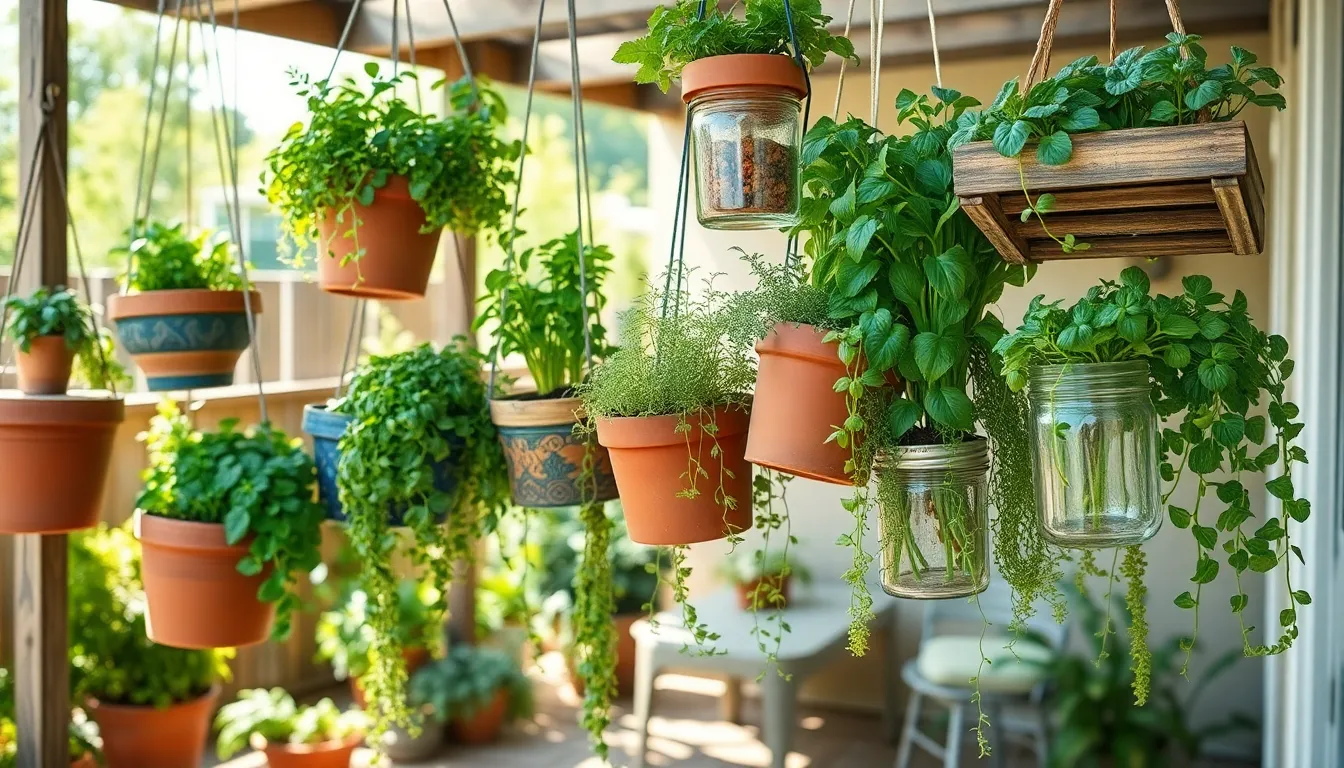
Transforming everyday objects into stunning hanging planters opens up endless possibilities for creating unique garden displays. We’ll explore innovative ways to repurpose common household items and arrange containers for maximum visual impact.
Repurposed Household Items as Planters
Old pots and pans make excellent planters for herbs or succulents once you clean them thoroughly and add drainage holes. We recommend using stainless steel or enamel cookware since they’re naturally weather-resistant and add an industrial charm to your hanging garden display.
Wooden crates transform into rustic hanging planters that perfectly complement farmhouse or cottage-style outdoor spaces. We suggest lining them with industry fabric to prevent soil spillage while maintaining proper drainage for healthy plant growth.
Plastic containers like yogurt cups or food storage boxes work wonderfully for lightweight hanging gardens when you drill holes in the bottom. We’ve found these containers especially useful for starting seedlings or growing small herbs indoors where weight becomes a concern.
Tiered Hanging Basket Arrangements
Hanging baskets at different heights maximizes light exposure while creating a ever-changing visual display that draws the eye upward. We position our tallest containers at shoulder height and graduate downward to create natural viewing angles for each plant.
Layered arrangements work best when you select plants with varying growth habits and textures to complement each other. We pair upright plants like geraniums in top baskets with trailing varieties like petunias in lower positions for a cascading waterfall effect.
Trailing herbs like thyme or oregano add both beauty and functionality to tiered systems since they naturally drape over basket edges. We’ve discovered that positioning aromatic herbs at eye level makes harvesting easier while releasing pleasant fragrances as you walk by.
Mason Jar and Bottle Garden Displays
Mini herb gardens in mason jars create charming displays perfect for kitchen windows or covered patios where you need easy access to cooking ingredients. We fill standard 16-ounce jars with herbs like basil or mint, which thrive in smaller root spaces and provide continuous harvests.
Terrariums using glass bottles or large jars house succulents or mosses that require minimal maintenance while adding sophisticated elegance to any space. We select drought-tolerant plants like air plants or small cacti that naturally adapt to enclosed glass environments.
Hanging bottle gardens work exceptionally well when you use wine bottles or large mason jars suspended from macramé hangers or wire brackets. We’ve found that clear glass containers showcase root development beautifully while colored glass adds artistic flair to your hanging garden collection.
Herb and Vegetable Hanging Garden Ideas
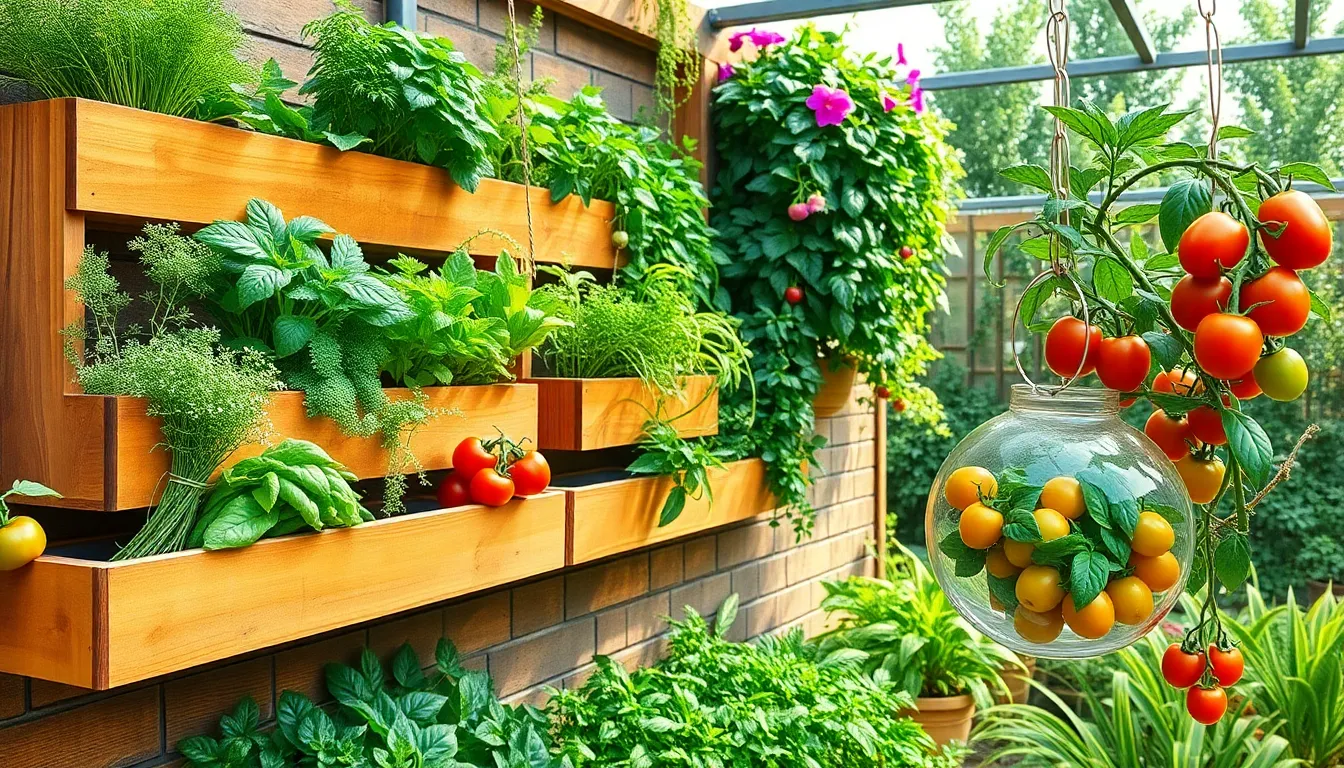
Transforming unused wall space into productive growing areas creates opportunities for fresh food right at your fingertips. We’ve compiled innovative approaches that maximize harvest potential while maintaining beautiful aesthetics.
Kitchen Herb Garden Installations
Vertical hydroponic systems revolutionize year-round herb production by delivering nutrients directly to plant roots without soil. These installations allow efficient growth in minimal space while maintaining consistent harvests throughout all seasons.
DIY wooden box wall planters provide rustic charm combined with practical functionality for kitchen herb cultivation. Mount these custom-built containers on walls or fences to create dedicated growing zones for essential cooking herbs like basil, oregano, and cilantro.
Modular wall-mounted planters offer expandable answers using materials like repurposed pallets or cleaned gutters. Configure these systems to accommodate different herb sizes, from compact chives to spreading rosemary plants that require more root space.
Vertical Vegetable Growing Systems
Ladder-style vertical gardens maximize growing potential by creating multiple planting levels for vegetables like cherry tomatoes and radishes. Repurpose old stepladders or construct tiered shelving units that provide adequate spacing between each growing tier.
Trellised climbing vegetables use vertical support structures for pole beans, cucumbers, and peas that naturally grow upward. Construct these supports from wood, wire, or netting materials that can handle the weight of mature plants and their harvest.
Hanging globe planters showcase small vegetables in sleek, minimalist designs that complement modern outdoor spaces. These spherical containers work particularly well for compact varieties like cherry tomatoes, small peppers, and baby lettuce that don’t require extensive root systems.
Edible Flower Hanging Arrangements
Hanging diamond planters create striking geometric displays perfect for small edible flowers like violas and pansies. These angular containers hang easily in any room while providing adequate drainage for delicate flowering plants.
Fabric or felt pocket gardens offer space-saving answers for growing edible flowers like nasturtiums and trailing petunias. Mount these soft containers on walls or fences to create vertical flower gardens that produce colorful, flavorful additions to salads and garnishes.
Patterned ceramic planters combine decorative appeal with functional growing space for edible flowers that enhance both garden beauty and culinary options. Choose containers with proper drainage holes to prevent root rot while showcasing colorful blooms like calendulas and Johnny jump-ups.
Succulent and Air Plant Hanging Gardens
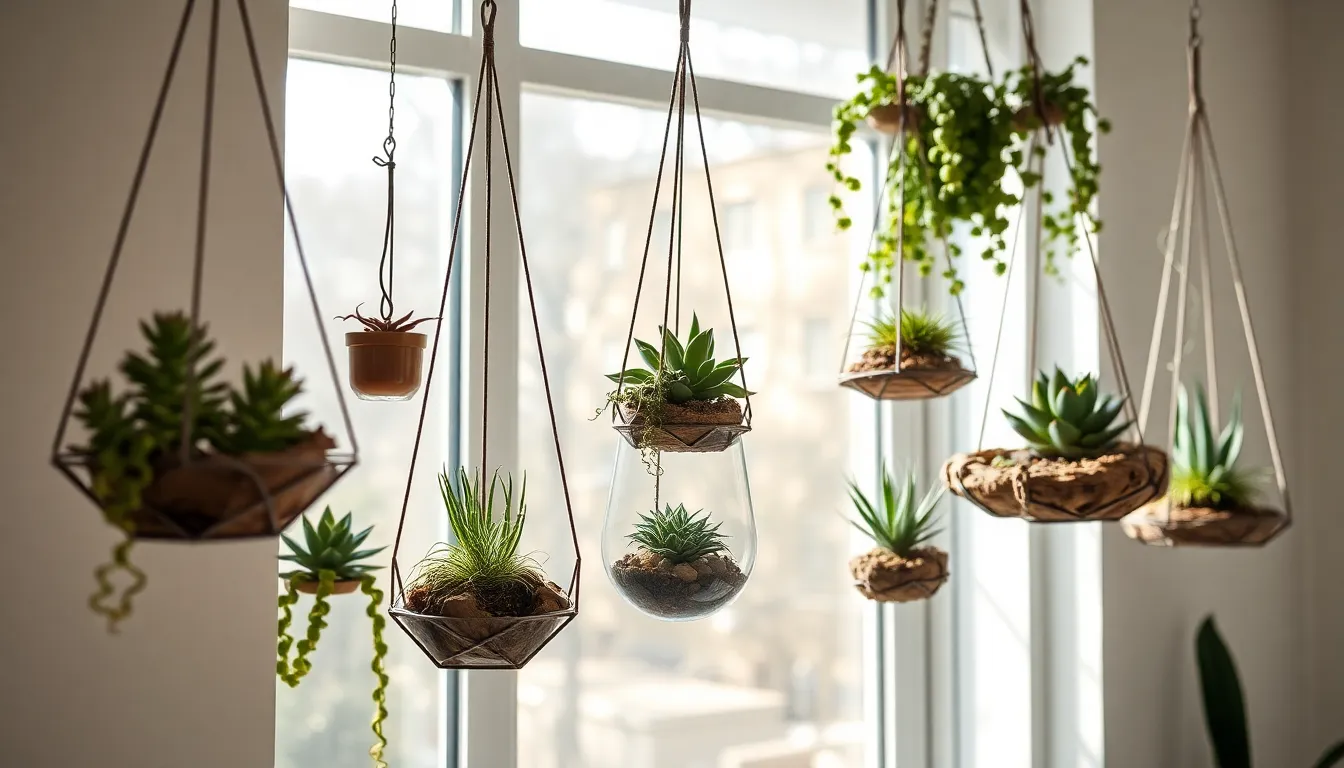
Succulents and air plants transform any space into a stunning vertical oasis while requiring minimal maintenance effort. These drought-tolerant beauties thrive in hanging displays that showcase their unique textures and forms.
Geometric Hanging Terrarium Designs
Geometric terrariums create striking focal points when filled with carefully selected succulents like echeveria, jade plants, and string of pearls. Glass or acrylic containers in triangular, hexagonal, and diamond shapes add modern sophistication to your hanging garden collection.
We recommend positioning these terrariums near bright windows where filtered light enhances the geometric shadows while providing optimal growing conditions. Small air plants such as Spanish moss and tillandsia fit perfectly within angular spaces, creating living art pieces that require only weekly misting.
Decorative pebbles and colored sand layers add visual depth while supporting proper drainage for your succulent arrangements. Hanging these geometric displays at varying heights creates a ever-changing installation that draws the eye upward and maximizes your vertical growing space.
Driftwood and Natural Material Displays
Driftwood hanging gardens bring coastal charm and rustic elegance to both indoor and outdoor spaces through creative plant partnerships. Natural wood pieces provide perfect mounting surfaces for air plants while creating organic shapes that complement modern and traditional décor styles.
We suggest drilling small holes or utilizing existing crevices in driftwood to secure wire hangers and create planting pockets for succulents like hens and chicks or burro’s tail. Cork bark, weathered branches, and reclaimed barn wood offer similar opportunities for rustic hanging garden displays.
Air plants naturally attach to rough bark surfaces, making driftwood an ideal growing medium that requires no soil or complex installation procedures. These living sculptures work particularly well in bathrooms and kitchens where humidity levels support healthy air plant growth.
Minimalist Suspended Garden Concepts
Minimalist hanging gardens focus on clean lines and simple forms that highlight the natural beauty of succulents and air plants without overwhelming visual clutter. Wire frames, sleek metal hangers, and geometric macramé designs create elegant suspension systems for small planters.
We prefer using matching containers in neutral colors like white, black, or natural clay to maintain visual consistency across multiple hanging elements. Single plant displays in each container prevent overcrowding while allowing individual specimens like air plant varieties or small cacti to shine as living sculptures.
Small terracotta pots, ceramic vessels, and glass orbs work beautifully within minimalist frameworks when suspended at strategic intervals throughout your space. These suspended gardens require minimal watering schedules, making them perfect for busy lifestyles while adding sophisticated green accents to modern living areas.
Low-Maintenance Hanging Garden Ideas

Creating beautiful hanging gardens doesn’t require extensive gardening experience or daily attention. We’ve discovered that selecting the right plants and systems can make your vertical garden thrive with minimal effort.
Drought-Tolerant Plant Selections
String of Pearls leads our list of low maintenance hanging plants because of its exceptional drought tolerance and cascading growth pattern. This unique succulent requires watering only once every two weeks and creates stunning visual interest with its bead-like foliage.
Echeveria and Crassula varieties offer colorful rosette formations that store water in their thick leaves. These succulents can survive up to three weeks without watering and produce beautiful flower spikes during blooming season.
Geraniums provide vibrant color options while maintaining hardy perennial characteristics that withstand various weather conditions. We recommend these plants for their ability to bloom continuously with minimal feeding and their resistance to common garden pests.
Heuchera delivers year-round foliage interest with its colorful leaves that transition through seasons. This plant requires regular watering and feeding but rewards gardeners with consistent beauty and cold weather resilience.
Bacopa creates gentle trailing effects with delicate blooms that last from summer through fall. Position these plants in partial shade areas where they’ll produce cascading white or pink flowers with moderate water requirements.
Self-Watering Hanging Systems
Self-watering baskets eliminate the guesswork from plant care by allowing roots to draw moisture as needed. These systems include water reservoirs that can sustain plants for up to two weeks depending on weather conditions and plant size.
Wick-based watering systems use cotton or synthetic wicks to transport water from reservoirs directly to plant roots. We’ve found that these systems work particularly well for herbs like basil, mint, and rosemary that require consistent moisture levels.
Drip irrigation attachments connect to standard garden hoses and deliver precise water amounts to multiple hanging containers simultaneously. Install timers with these systems to automate watering schedules and reduce maintenance time by up to 80%.
Water-storing gel crystals mixed into potting soil expand when wet and slowly release moisture to plant roots. These crystals can extend watering intervals by 3-5 days and work especially well in hot climates or sunny locations.
Seasonal Hanging Garden Rotations
Spring installations focus on bright flowering plants like geraniums combined with fresh herbs such as basil and mint. Start these gardens after the last frost date in your area and expect blooms within 4-6 weeks of planting.
Summer transitions incorporate drought tolerant succulents like String of Pearls alongside heat loving Bacopa for continuous color. These combinations require watering only twice weekly and provide visual interest through the hottest months.
Fall arrangements feature ornamental cabbage and kale varieties that thrive in cooler temperatures and provide unique textures. Add these plants in late August for peak color display during autumn months.
Winter displays use evergreen plants like Heuchera to maintain garden interest when other plants go dormant. Choose cold hardy varieties that can withstand temperatures down to 10°F while providing consistent foliage color.
Edible rotations include lettuce and strawberry plants that can be harvested throughout their growing seasons. Plant strawberries in spring for summer fruit production and lettuce in both spring and fall for extended harvest periods.
Conclusion
Creating your dream hanging garden doesn’t have to be overwhelming or expensive. We’ve shown you countless ways to transform any space into a thriving vertical oasis that fits your lifestyle and budget.
Whether you’re drawn to the rustic charm of repurposed containers or the sleek efficiency of hydroponic systems we’ve covered options for every preference. The beauty of hanging gardens lies in their flexibility – you can start small with a single macrame planter and expand as your confidence grows.
Remember that successful hanging gardens combine function with beauty. Choose plants that match your maintenance schedule and lighting conditions while creating the visual impact you desire.
Your vertical gardening journey starts now. Pick one idea that resonates with you and take that first step toward transforming your space into the green sanctuary you’ve always wanted.
Frequently Asked Questions
What are hanging gardens and why are they beneficial?
Hanging gardens are vertical gardening solutions that utilize suspended planters, wall-mounted systems, or elevated containers to grow plants without requiring ground space. They’re perfect for saving space, enhancing aesthetic appeal, and overcoming limitations like poor soil conditions. These gardens work well for both indoor and outdoor spaces, making them ideal for apartments, patios, and balconies.
Can beginners successfully create hanging gardens?
Yes, hanging gardens are suitable for all skill levels, including complete beginners. Start with low-maintenance options like succulent displays or simple macrame plant hangers. Choose drought-tolerant plants, use self-watering systems, and begin with easy-to-grow varieties like herbs or trailing plants. Many DIY options use everyday household items, making them budget-friendly and accessible.
What types of plants work best in hanging gardens?
The best plants for hanging gardens include trailing varieties like pothos and ivy, compact herbs such as basil and thyme, drought-tolerant succulents, air plants, and small vegetables like cherry tomatoes. Choose plants based on your space’s light conditions and maintenance preferences. Cascading plants create beautiful visual effects, while upright varieties maximize growing space.
How do I maintain hanging gardens with minimal effort?
Choose drought-tolerant plants like String of Pearls or Echeveria that require less frequent watering. Install self-watering systems with wick-based irrigation or drip attachments. Position plants according to their light needs and rotate seasonal varieties for year-round interest. Group plants with similar care requirements together to simplify maintenance routines.
What materials work best for outdoor hanging gardens?
Use weather-resistant materials including UV-stabilized plastics, powder-coated metals, and treated woods for outdoor hanging gardens. These materials withstand harsh weather conditions and UV exposure. Ensure secure mounting systems to handle wind conditions, and consider self-watering features to reduce maintenance needs during hot weather or when traveling.
Can I grow vegetables and herbs in hanging gardens?
Absolutely! Hanging gardens are excellent for growing herbs like basil, cilantro, and parsley, as well as compact vegetables such as cherry tomatoes, peppers, and lettuce. Use deeper containers for root vegetables and install trellises for climbing varieties. Vertical hydroponic systems work particularly well for year-round herb production with consistent harvests.
How do I create hanging gardens on a budget?
Repurpose household items like old pots, wooden crates, mason jars, and plastic containers as planters. Build DIY pallet gardens using reclaimed wood, or create macrame hangers with inexpensive cord. Use fabric pocket systems for affordable living walls, and propagate plants from cuttings instead of buying new ones to minimize costs.
What are the best hanging garden ideas for small indoor spaces?
For small indoor spaces, try macrame plant hangers for trailing plants, ceiling-mounted garden rails for succulents, and window hanging displays for herbs. Mason jar herb gardens work well in kitchens, while geometric terrariums create striking focal points. These solutions maximize vertical space while adding natural beauty to interior environments.

